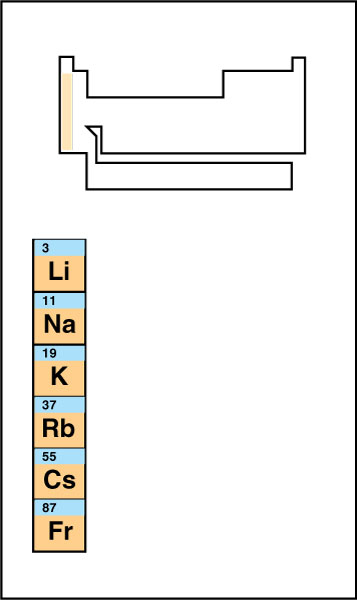Alkali metal, << AL kuh ly, >> in chemistry, refers to six chemical elements: lithium, sodium, potassium, rubidium, cesium, and francium. These elements make up group 1 of the periodic table. Compounds of alkali metals rank among the most common and most useful of all chemicals. Millions of tons of alkali metal salts are used by industry each year. The salts come from mines and wells. Sodium and potassium salts are raw materials for sodium hydroxide and potassium hydroxide. These alkali metal compounds and others made from them are used in making glass, paper, soap, and textiles; in refining petroleum; and in preparing leather. The word alkali comes from the Arabic word al-qili, meaning plant ashes. Plant ashes were the first source of alkali metal compounds.

When used alone, the word alkali can refer to alkali metal hydroxides, and sometimes to alkali metal carbonates. An alkali metal hydroxide is a compound that contains an alkali metal positive ion and a negative hydroxide ion. Sodium hydroxide (NaOH) and potassium hydroxide (KOH) are alkalis. When the term alkali metal precedes another word, as in alkali metal halide, it refers to the presence of a positive ion of an alkali metal. The salt sodium chloride (NaCl) is an alkali metal halide. It is made of the positive ion of the alkali metal sodium, and the negative ion of the halogen chlorine.
In nature, alkali metals always occur in compounds. A process called electrolysis can separate the metals from their salts and hydroxides. An average sample of Earth’s crust is about 2.8 percent sodium, 2.6 percent potassium, 0.034 percent rubidium, 0.034 percent cesium, and 0.007 percent lithium. Francium, a radioactive alkali metal, occurs only briefly when uranium decays.
With the exception of minerals known as common silicates, most alkali compounds dissolve easily in water. Rain washes these compounds from the soil. The compounds then collect in the ocean and in lakes that have no outlets, such as Great Salt Lake in Utah. The evaporation of ancient seas and lakes left vast deposits of alkali salts throughout the world.
The alkali metals all form singly charged positive ions, and are extremely reactive chemically. They react violently with water, forming hydroxides and releasing hydrogen gas and heat.
